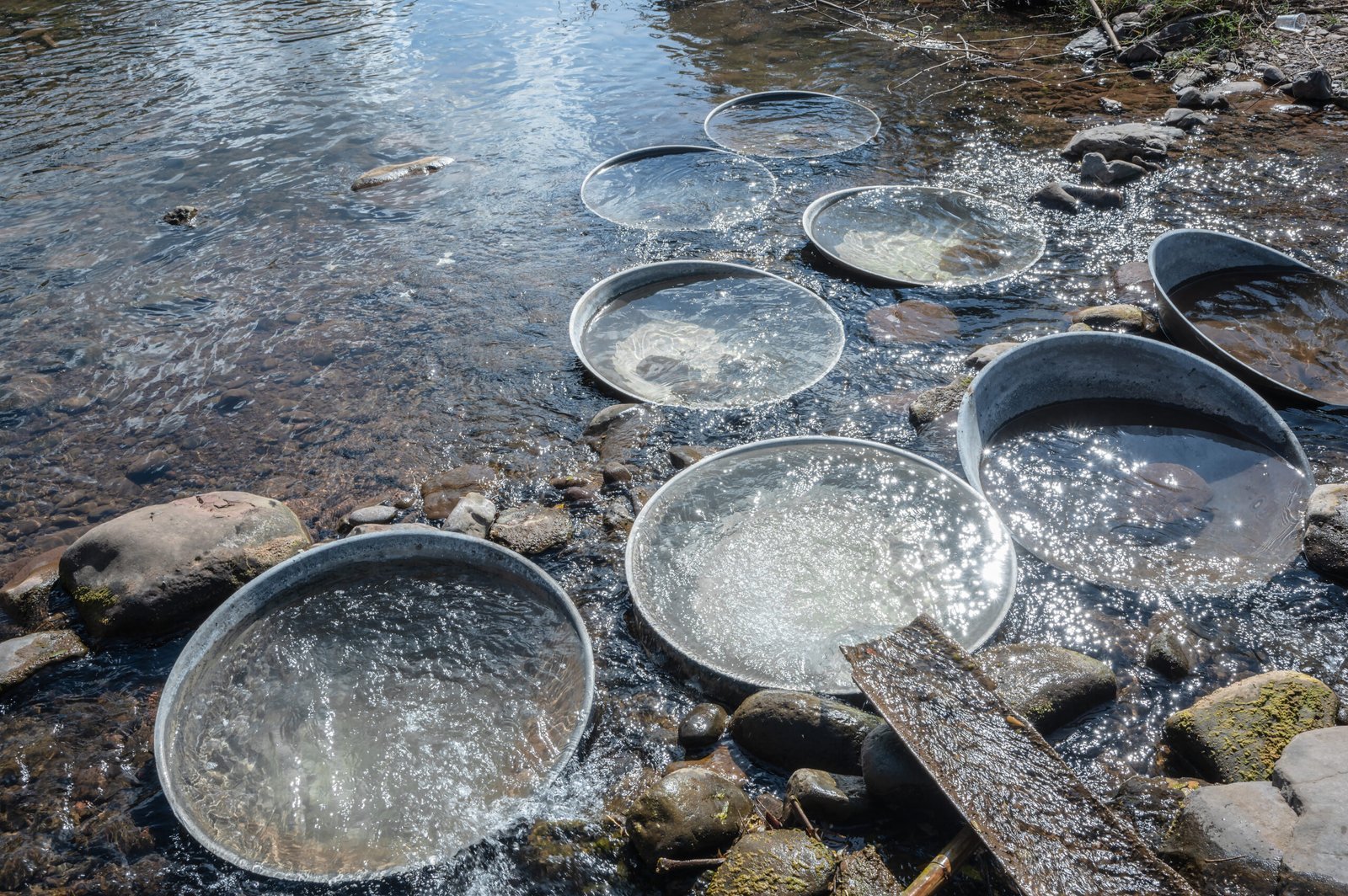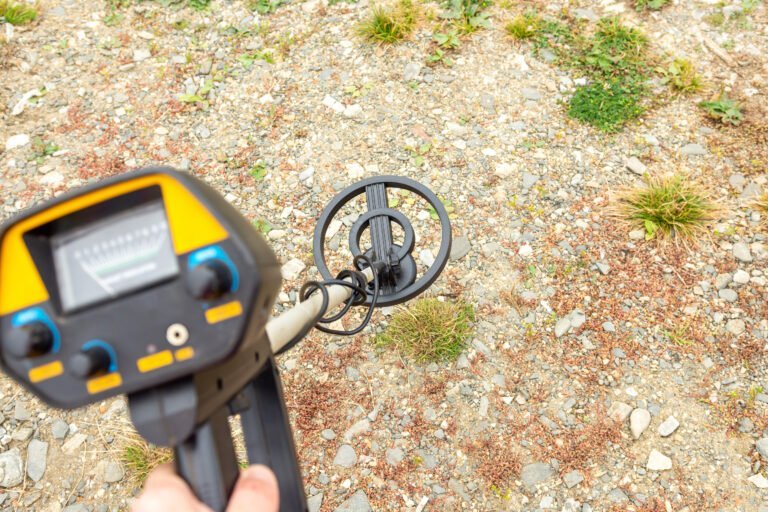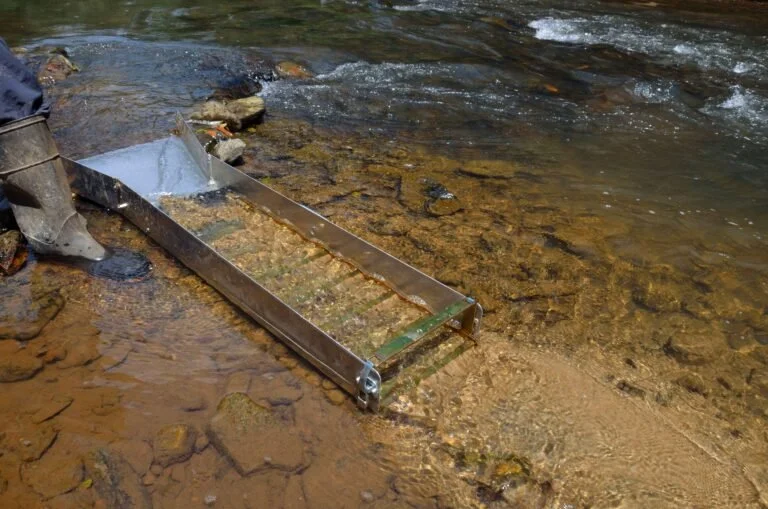If you’re interested in embarking on a gold mining adventure but don’t want to spend a fortune on expensive equipment, don’t worry!
First Posted November 29, 2024 | Last Updated on July 29, 2025 by Ryan ConlonDisclosure: This Post Contains Affiliate Links; We earn a commission on purchases.
You can easily create your own DIY gold mining equipment using simple tools and materials.
In this article, we’ll provide you with tips and ideas on how to build your own gold mining gear. From homemade gold pans to hand-fed sluice boxes, we have you covered.
Key Takeaways:
- Building your own DIY gold mining equipment can save you money.
- You can create homemade gold pans, dredges, sluice boxes, and more.
- Designing and constructing your own gear gives you a sense of accomplishment.
- Always prioritize safety and follow local regulations when gold mining.
- Enjoy the adventure of finding gold and may your pan fill with golden treasures!
Make Your Own Gold Pan
When it comes to gold prospecting, having a gold pan is essential. While you can easily purchase one, there may be situations where you need to improvise and create your own “emergency” gold pan. In this section, we’ll provide you with the information you need to know about making your own gold pan using readily available materials.
“Having a gold pan is like having a trusty companion in your gold hunting journey. It’s a versatile tool that allows you to separate gold from other materials and gives you a glimpse into the riches that lie beneath the surface. But what if you find yourself in a situation where a store-bought pan is not available? Fear not, you can easily create your own gold pan using simple materials.”
To make your own gold pan, you’ll need a few basic supplies, including:
- A sturdy plastic container or metal pie pan (preferably with a flat bottom)
- A small round file or sandpaper
- A handheld drill with a small drill bit
Here’s a step-by-step guide to creating your DIY gold pan:
- Prepare the pan: If you’re using a plastic container, ensure that it has a flat bottom. If necessary, trim the edges to create a more circular shape. If you’re using a metal pie pan, ensure that it’s clean and free from any coatings.
- Create riffles: Riffles are ridges or grooves on the bottom of the pan that help trap the gold. Use a small round file or sandpaper to create riffles along one edge of the pan. These riffles should be around half an inch wide and spaced about an inch apart.
- Drill a hole: On the opposite side of the riffles, drill a small hole near the top edge of the pan. This hole will allow you to attach a lanyard or rope to secure the pan while panning.
Once you’ve completed these steps, your DIY gold pan is ready for action! Head to a nearby stream or river, scoop up some sediment and gravels, and give your pan a gentle swirling motion. The lighter materials will wash away, leaving the heavier gold particles behind in the riffles.
Tips for Using Your DIY Gold Pan:
- Choose a spot in the stream where the water is relatively calm and slow-moving to make panning easier.
- Use your pan to scoop up material from the riverbed, focusing on areas where gold is likely to settle, such as behind large rocks or in crevices.
- Always make sure to work with clean water to avoid contaminating your gold samples.
- Practice your panning technique by gently swirling the pan back and forth while gradually pouring out the lighter materials.
- Don’t forget to patience and enjoy the process. Gold panning is not just about finding treasure-it’s also about connecting with nature and experiencing the thrill of the hunt.
So, whether you’re out in the wild hunting for gold or find yourself in a pinch without a store-bought pan, you now know how to create your very own gold pan. Remember, it’s not just a tool but a symbol of adventure and possibility. Happy panning!
Design and Build Your own Gold Dredge
If you’re interested in finding gold nuggets, owning a gold dredge can greatly increase your chances. However, purchasing a dredge can be expensive. That’s where building your own homemade suction gold dredge comes in. In this section, we’ll share plans and information on how to design and construct your own dredge, based on years of experience in the field.
Building your own homemade gold dredge is not as challenging as it may seem. With the right materials and a little bit of know-how, you can create a high-performing dredge that rivals store-bought options.
Designing Your Dredge
Before diving into the construction process, it’s important to have a solid design plan for your gold dredge. Factors to consider include the size of the dredge, the type of engine you’ll use, and the materials you’ll need.
Start by determining the size of your dredge based on the amount of gold-bearing material you’ll be working with. A larger dredge will allow you to process more material in less time, but keep in mind that it may be more challenging to transport and operate.
Next, consider the engine options for your dredge. Most homemade gold dredges utilize small engines like a 5-7 horsepower water pump engine or a 2-3 horsepower gasoline engine. Choose an engine that is powerful enough to provide sufficient suction for effective gold recovery.
Lastly, gather the necessary materials for your dredge. This may include PVC pipes, hoses, mesh, metal grates, and other components that will form the structure and functionality of your dredge.
Constructing Your Dredge
Once you have your design plan and materials ready, it’s time to start building your gold dredge. Begin by assembling the frame using PVC pipes and fittings, ensuring that it is sturdy and capable of withstanding the rigors of dredging.
Next, attach the hoses and suction nozzles to the frame. These components will be responsible for creating suction and capturing gold-bearing material. Make sure to seal the connections properly to prevent any leaks.
Install the engine and water pump to power the suction system. Follow the manufacturer’s instructions for proper installation and ensure that all connections are secure.
Lastly, add the necessary mesh, metal grates, and riffles to the dredge to trap and collect the gold. These components will help separate the heavier gold particles from the lighter material.
With your gold dredge now constructed, it’s time to put it to the test. Find a suitable gold-bearing stream or river, and start operating your dredge by diving underwater and suctioning the material rich in gold.
Building your own gold dredge is not only a cost-effective alternative but also provides a sense of accomplishment. With the right design and construction, you can have a reliable and efficient tool for capturing gold. Remember to always follow safety guidelines and obtain any necessary permits before using your homemade gold dredge.
Build Your Own Dredge Sluice Box
The sluice box is a crucial component of any dredge setup. It is responsible for catching the gold particles and separating them from the unwanted materials. Without an effective sluice box, using a dredge would be inefficient and yield poor results. Whether you are looking to build your own sluice box for a new dredge or upgrade your existing one, this section will provide you with the necessary information to consider and guide you through the process of building a high-performing sluice box.
When constructing a DIY gold sluice box, several factors need to be taken into consideration. These include the size and dimensions of the sluice box, the type and angle of the riffles, and the materials used. A well-designed sluice box ensures maximum gold recovery while minimizing the loss of valuable material.
To help you get started, here are some key points to consider:
- Material Selection: Choose durable and lightweight materials like aluminum or stainless steel for the sluice box body. These materials are resistant to rust and corrosion, ensuring longevity and optimal performance.
- Design Considerations: The design of the riffles plays a critical role in capturing the gold particles. Various types of riffles, such as Hungarian, Vortex, or expanded metal, can be used. Additionally, ensure the sluice box has the appropriate slope or angle for efficient gold recovery.
- Modularity: Consider building a modular sluice box that can be easily disassembled and transported. This allows for convenience and flexibility, especially if you plan to prospect in different locations.
- Cleaning and Maintenance: Ensure the design of your sluice box allows for easy cleaning and maintenance. Regularly remove and clean the riffles to prevent any buildup of unwanted materials that could hinder gold recovery.
For a visual guide and detailed instructions on building your own gold sluice box, refer to the following diagram:
| Component | Material | Dimensions |
|---|---|---|
| Sluice Box Body | Aluminum | 36″ x 8″ x 6″ |
| Riffles | Hungarian | 24″ x 4″ x 0.5″ |
| Matting | Rubber | 36″ x 8″ |
| Adjustable Legs | Steel | Adjustable height: 18″ to 24″ |
Remember, building a high-quality sluice box requires attention to detail and careful craftsmanship. Invest your time and effort into constructing a sturdy and efficient sluice box, and it will pay off during your gold mining adventures.
Plans to Build Your Own Hand Fed Sluice Box
Moving up from using a gold pan, a hand-fed river sluice box can process more material in an hour than you can pan in a day. It’s a valuable tool for serious gold prospectors looking to increase their efficiency and maximize their gold recovery. In this section, we’ll provide you with comprehensive plans and information on how to design and construct your own hand-fed sluice box, giving you the freedom to tailor it to your specific needs and preferences.
Building a hand-fed sluice box is a rewarding project that combines practicality with creativity. By following our step-by-step instructions and utilizing readily available materials, you can create a sluice box that is both effective and durable. Whether you’re a seasoned prospector or just starting out, this DIY project will help you get one step closer to finding that elusive yellow metal.
Design Considerations
Before you begin building your hand-fed sluice box, it’s important to consider design factors that will contribute to its performance. Here are some key aspects to keep in mind:
- Size: Determine the desired length, width, and height of your sluice box based on factors such as the amount of material you plan to process and the size of gold particles you expect to encounter.
- Riffle Design: Choose the type and configuration of riffles that will provide optimal gold trapping and retention. The design of riffles plays a crucial role in the efficiency of your sluice box.
- Adjustability: Consider incorporating adjustable features into your sluice box design. This will allow you to adapt to different water flow rates and gold concentrations.
- Portability: Think about the ease of transporting your sluice box to different mining sites. It should be sturdy enough to withstand rugged outdoor conditions while also being lightweight and portable.
By addressing these design considerations, you can create a hand-fed sluice box that is customized to suit your specific mining requirements.
Step-by-Step Construction Guide
To help you build your own hand-fed sluice box, we’ve compiled a detailed step-by-step construction guide:
- Gather all the necessary materials and tools, including plywood, aluminum or steel sheeting, riffle matting, and silicone adhesive.
- Cut the plywood into the desired dimensions for the base, sides, and riffle assemblies of your sluice box.
- Assemble the base and sides of the sluice box using screws or nails.
- Attach the riffle assemblies to the base of the sluice box, making sure to create proper spacing between the riffles for optimal gold capture.
- Secure the riffle matting to the riffle assemblies using silicone adhesive, ensuring a tight seal.
- Add any additional features or enhancements to your sluice box, such as adjustable legs or a classifier screen.
- Test your hand-fed sluice box in a controlled environment, making any necessary adjustments to optimize its performance.
Remember to consult the detailed plans and diagrams provided in our comprehensive guide for a more thorough understanding of the construction process.
Building your own hand-fed sluice box not only saves you money but also allows you to fine-tune its design to suit your specific mining needs. Whether you’re prospecting in rivers, streams, or other water bodies, utilizing a hand-fed sluice box will greatly increase your productivity and gold recovery rates. Join the long-standing tradition of miners who have been making their own sluices since the gold rush and take control of your gold prospecting journey.
| Advantages | Disadvantages |
|---|---|
| Customizable to suit your specific needs and preferences | Requires time and effort for construction |
| Cost-effective compared to purchasing a ready-made sluice box | Requires basic woodworking skills and tools |
| Allows for experimentation and optimization | May require trial and error to achieve desired performance |
Plans to Build Your Own Dry Washer
If you’re planning to prospect for gold in the desert, a dry washer is an essential piece of equipment. Unlike traditional sluice boxes or panning methods, a dry washer uses air to separate gold from the surrounding material. Building your own dry washer can be a doable project with a little planning, good design, and some work. In this section, we’ll provide you with plans and thoughts on how to construct your own dry washer for efficient gold recovery in arid environments.
Gather the Necessary Materials
Before you start building your dry washer, it’s important to gather all the necessary materials. Here’s a list of what you’ll need:
- Wood or metal for the frame
- Mesh screen for the riffle tray
- Blower or bellows for airflow
- Hopper for feeding material
- Various screws, nuts, and bolts for assembly
Designing and Building Your Dry Washer
Once you have all the materials ready, it’s time to design and build your dry washer. Here are some key steps to follow:
- Start by constructing the frame using the chosen wood or metal.
- Create a riffle tray by attaching the mesh screen to capture the gold. Ensure proper angle and placement for efficient gold recovery.
- Attach the blower or bellows to provide the necessary airflow for separation.
- Build a hopper to feed material into the dry washer. Make sure it’s sturdy and capable of holding a sufficient amount of material.
- Assemble all the components securely, ensuring proper alignment and stability.
Remember to take into account the size and weight of the dry washer when designing the frame. This will ensure ease of transportation and maneuverability in the field.
Troubleshooting and Optimization
Once you’ve built your dry washer, it’s important to test and refine its performance. Here are some troubleshooting and optimization tips:
- Experiment with different angles and airflow settings to optimize gold recovery.
- Regularly clean and inspect the riffle tray to prevent clogging and maximize efficiency.
- Consider adding adjustable legs to ensure stability on uneven ground.
Final Thoughts
Building your own dry washer can be a rewarding project that allows you to customize your equipment to suit your specific needs. By following the provided plans and guidelines, you’ll be well on your way to creating an efficient dry washer for prospecting gold in arid environments. Remember to always prioritize safety and follow local regulations while engaging in gold mining activities.
Build Your Own Gold High Banker
A high banker is a versatile piece of prospecting equipment that can work bench gravels left high and dry by river erosion. It allows you to efficiently separate gold from other materials by utilizing a combination of water flow and gravity. Building your own high banker is not overly complicated, and it can save you money while providing you with a valuable tool that works effectively in various mining situations.
When building your own gold high banker, there are two main elements that you need to consider: the feed box and the sluice box. The feed box is where you deposit the materials to be processed, and the sluice box is where the gold is captured as the materials flow through. By customizing these elements to suit your specific needs, you can optimize gold recovery and increase efficiency.
Here’s a breakdown of the key components of a high banker:
- Feed Box: This is where you deposit the gravel, sand, and other materials to be processed. It is important to design a feed box that allows for even distribution of materials across the sluice box, ensuring efficient gold recovery.
- Sluice Box: The sluice box is where the gold is captured as the materials flow through. It consists of various riffles, matting, and miners moss that create barriers and trap the heavier gold particles.
- Water System: A high banker requires a water source to provide the necessary flow for processing materials and capturing gold. You can either use a pump or rely on gravity-fed water.
- Adjustable Legs: To ensure stability and proper positioning, adjustable legs are essential. They allow you to set up the high banker on uneven terrain and adjust the angle of the sluice box for optimal gold recovery.
Building your own gold high banker gives you the freedom to customize it according to your specific needs and preferences. You can choose the size, shape, and materials that work best for your mining conditions. By understanding the principles and techniques of high banking, you can create a highly efficient and effective piece of equipment.
Incorporating a high banker into your gold mining setup can significantly enhance your prospecting efforts. Not only will you have greater control over the processing of materials, but you’ll also have the satisfaction of using equipment that you built yourself. It’s a rewarding experience that allows you to fine-tune your equipment to maximize gold recovery.
Building your own gold high banker not only saves you money but also gives you the opportunity to customize the equipment according to your needs. With a well-designed high banker, you can efficiently recover gold from bench gravels and increase your chances of finding valuable deposits. Start your DIY project today and embark on a rewarding gold mining adventure.
| Advantages of Building Your Own Gold High Banker |
|---|
| 1. Cost savings compared to purchasing a commercial high banker |
| 2. Customizable design to suit your specific mining conditions |
| 3. Enhanced gold recovery through tailored modifications |
| 4. Sense of accomplishment from using equipment you built yourself |
Build Your Own Gold Shaker Table
Shaking tables, also known as wet tables, are essential tools for recovering gold from hard rock ores. While building your own gold shaker table can be a challenging project, the rewards are well worth the effort. In this section, we’ll provide you with the information you need to design and build your own table for efficient gold recovery.
Before embarking on this project, it’s important to understand the purpose of a gold shaker table. These tables use the process of shaking or vibrating to separate heavier and lighter materials, allowing the heavier gold particles to settle and be collected.
Building your own gold shaker table gives you the freedom to customize it to your specific needs and preferences. You can adjust the frequency and intensity of the shaking motion, the size and shape of the table, and the materials used for construction.
To get started, you’ll need a solid understanding of the basic components of a shaker table:
- Vibration mechanism: This is the part responsible for generating the shaking motion. It can be powered by an electric motor or a manual crank.
- Table surface: The surface of the table is where the material is placed for separation. It should be smooth and level to ensure proper distribution and movement of the particles.
- Riffles: These are raised bars or cleats along the length of the table. They help to create turbulence in the flowing water, which aids in separating the gold from the other materials.
- Water supply: A consistent flow of water is necessary to facilitate the separation process. The water should be controlled and regulated to ensure optimal performance.
When designing and building your own gold shaker table, you’ll need to consider factors such as the size of the table, the materials used, and the overall stability and durability of the structure. It’s important to consult resources and guides specific to shaker table construction to ensure proper functionality and effectiveness.
Remember that the success of your gold recovery process will depend on the design and construction of your shaker table. Take the time to research and plan your project thoroughly, and don’t hesitate to seek guidance from experienced prospectors or mining experts.
Comparison of Commercial Shaker Tables and DIY Designs
| Feature | Commercial Shaker Table | DIY Shaker Table |
|---|---|---|
| Cost | Higher cost due to manufacturing and branding | Lower cost as you can source materials locally |
| Customizability | Limited customization options | Highly customizable to meet your specific needs |
| Performance | Generally reliable and efficient | Performance varies based on design and construction quality |
| Portability | May be heavier and less portable | Can be designed with portability in mind |
| Construction Difficulty | N/A | Ranges from moderate to high, depending on complexity |
By building your own gold shaker table, you not only save money but also gain a deeper understanding of the gold recovery process. It’s a challenging yet rewarding DIY project that allows you to have full control over the design and functionality of your equipment.
“Designing and building your own gold shaker table is a testament to your passion for gold prospecting and adds a personal touch to your mining endeavors.” – Experienced Prospector
Make Your Own Hand Powered Rock Crusher
Breaking down large rocks into smaller pieces is essential in gold prospecting. While you can purchase a rock crusher, building your own can be a rewarding and cost-effective option. In this section, we’ll discuss different types of hand-operated rock crushers and provide you with the steps to create your own crusher for extracting gold from rocks.
Types of Hand-Powered Rock Crushers
When it comes to hand-powered rock crushers, there are a few different designs you can consider:
- CrazyCrusher: A portable rock crusher that can be hitched to your mining equipment or used by hand to crush rocks into fine powder.
- Mortar and Pestle: This traditional method involves using a mortar and pestle to manually crush rocks. While it requires physical effort, it can be an effective way to extract gold.
- Dolly Pot: A simple tool consisting of a metal container and a metal rod, the dolly pot allows you to crush rocks by hand.
Steps to Build Your Own Hand-Powered Rock Crusher
- Choose the design that best suits your needs and gather the necessary materials.
- Start by welding the metal plate to the bottom of the crusher to create a sturdy base.
- Attach the handle to the top of the crusher, ensuring it is securely fastened.
- Create a hopper by cutting out a section of metal or PVC pipe and attaching it to the top of the crusher.
- Using a metal grinder or file, shape the crusher’s teeth for optimal rock-crushing performance.
- Test the crusher by crushing a few rocks to ensure it functions properly.
- Make any necessary adjustments and modifications to improve the crusher’s efficiency.
- Your hand-powered rock crusher is now ready to use for extracting gold from rocks!
Remember to always use caution when handling rocks and equipment. Safety goggles and gloves are recommended when using a hand-powered rock crusher.
| Pros | Cons |
|---|---|
| Cost-effective alternative to purchasing a rock crusher | Requires manual effort and physical labor |
| Customizable design to suit your specific needs | May not have the same crushing power as commercial crushers |
| Can be used in remote locations where electricity is not available | Requires some welding and fabrication skills |
Build Your Own Gold Rocker
The rocker box was a commonly used piece of gold prospecting equipment during the California Gold Rush. Building your own rocker box can be a great option, especially if you’re mining small deposits where water is scarce. In this section, we’ll provide you with information on how to build your own rocker box using rough sawn lumber and portable materials.
Building a rocker box is a straightforward project that can yield rewarding results in your gold mining efforts. With the following steps and materials, you’ll be well on your way to constructing your very own gold rocker:
- Start by gathering the necessary materials:
- Rough sawn lumber (plywood or solid wood)
- Wood screws
- Aluminum sheeting
- Angle brackets
- Screening material
- Tools: saw, drill, screwdrivers
- Cut the lumber into the appropriate lengths:
- Create two sides for the rocker box, each measuring approximately [X] feet in length.
- Cut two crosspieces to attach to the sides, ensuring they align with the desired width of the box.
- Measure and cut a bottom piece to fit snugly between the sides.
- Create two rockers that will support the box, ensuring they align with the length of the sides.
- Assemble the rocker box:
- Attach the crosspieces to the sides using wood screws, forming a rectangular frame.
- Secure the bottom piece to the frame, creating the base of the rocker box.
- Attach one end of each rocker to the sides, ensuring they are positioned correctly for proper rocking action.
- Reinforce the rocker box:
- Use angle brackets to strengthen the joints of the frame.
- Line the inside of the box with aluminum sheeting to prevent rusting and improve gold recovery.
- Attach screening material to the bottom of the box, allowing for efficient separation of gold particles.
- Test and adjust:
- Place the rocker box on a level surface.
- Add a mixture of sand and small rocks to the box.
- Rock the box back and forth to simulate the motion of water washing away lighter materials and leaving behind heavier gold particles.
- Adjust the angle and positioning of the box as needed to optimize gold recovery.
Building your own gold rocker gives you the freedom to customize it to your specific needs and mining conditions. It’s a cost-effective solution that can provide you with years of reliable gold prospecting. With some patience and dedication, your DIY rocker box will be ready to help you uncover the treasures hidden beneath the surface.
Conclusion
Creating your own DIY gold mining equipment can be a rewarding and cost-effective endeavor. By following the tips and ideas provided in this article, you can build your own gold mining gear and embark on exciting treasure hunts to find that precious yellow metal.
Not only will building your own equipment save you money, but it will also give you a sense of accomplishment and independence. Whether you’re interested in homemade gold pans, hand-fed sluice boxes, or even gold dredges, there are plans and designs available to suit your needs.
However, it’s important to always prioritize safety and adhere to local regulations when engaging in gold mining activities. Take the time to educate yourself on proper techniques and equipment usage. By doing so, you can enjoy the adventure of finding gold while minimizing potential risks.
So get ready to build your own DIY gold mining equipment and let the golden color fill your pan regularly. Good luck on your treasure-hunting journey!
Source Links
- https://www.goldfeverprospecting.com/mayoowngopre.html
- http://nevada-outback-gems.com/design_plans/DIY_equipment.htm
- https://www.centralmontanaprospectorscoalition.com/let-s-make-equipment/

Meet Ryan Conlon, the passionate owner and driving force behind Pan for Treasure.
With an unwavering love for the art of gold panning, Ryan has transformed his enthusiasm into a thriving community hub for fellow treasure seekers. info@panfortreasure.com
A seasoned gold panning enthusiast, Ryan’s journey began with a simple pan and a dream, evolving into a deep appreciation for the history, geology, and thrill of uncovering precious metals.
Subscribe to Our Newsletter







